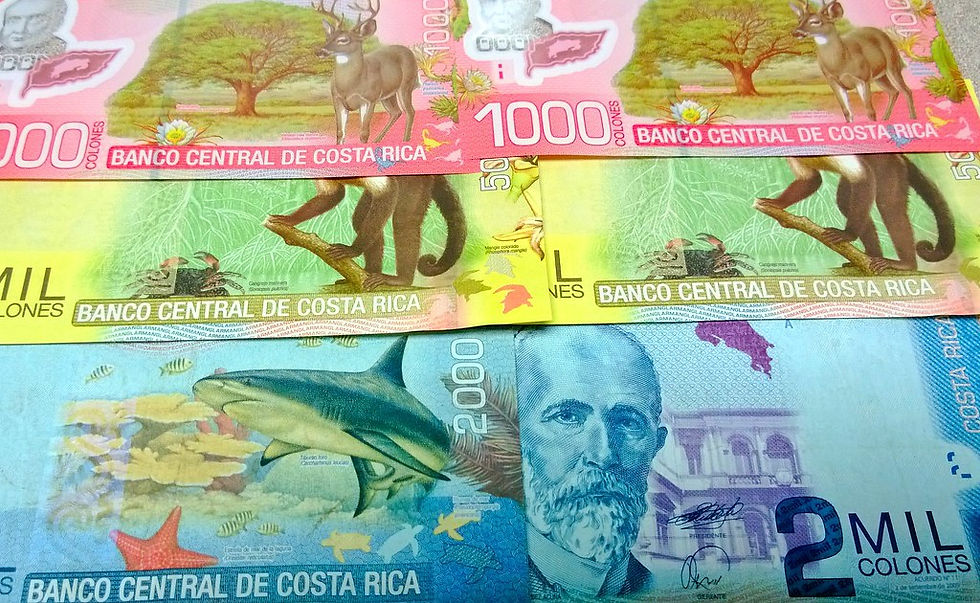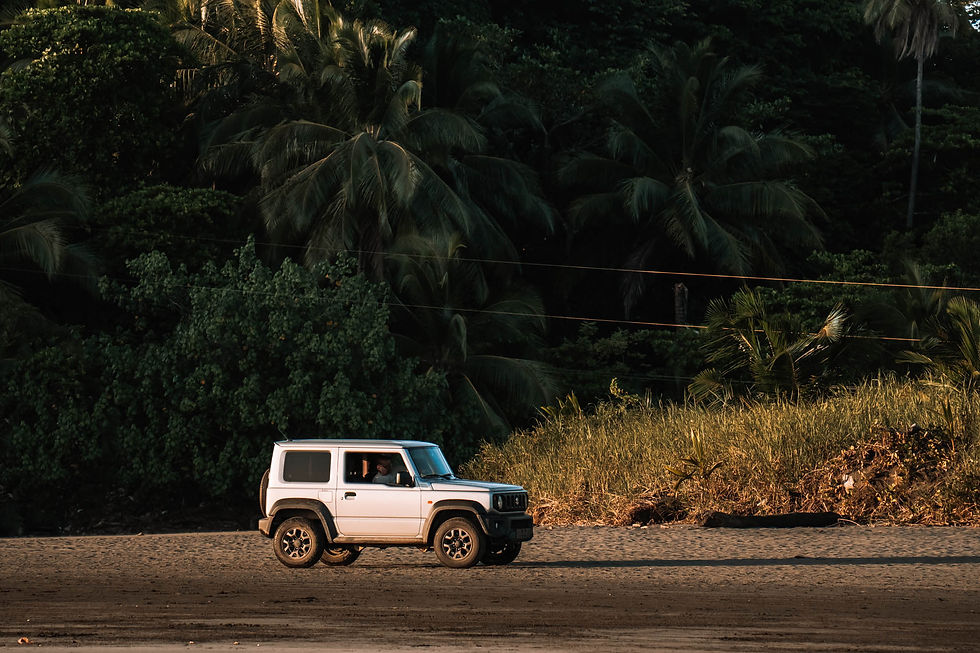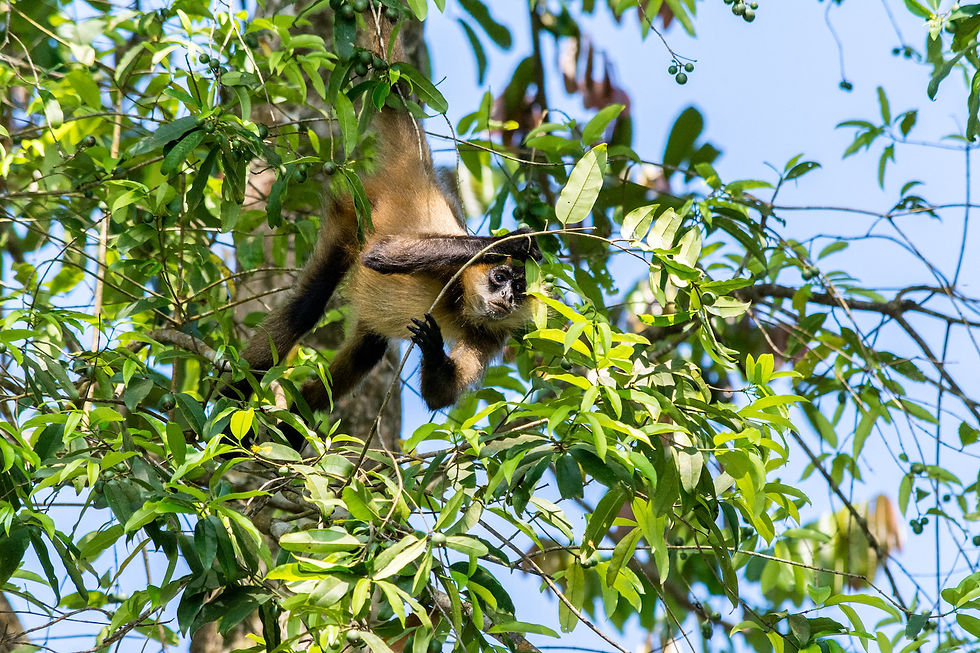15 Important Things to Know About Visiting Costa Rica in 2025
- Aurélise Leroux

- Aug 4
- 8 min read
Updated: Sep 18
Planning a trip to Costa Rica? Whether you're coming to surf the Pacific waves, explore lush rainforests, or simply relax on stunning beaches, there are a few key things to know before you land. This guide covers essential tips that will help you travel smarter, avoid common surprises, and enjoy the pura vida lifestyle to the fullest.

1. Costa Rica is One of the Safest Countries in Central America
Costa Rica consistently ranks as one of the safest countries in Latin America. Violent crime is rare in tourist areas, and political stability and a strong health care system contribute to its reputation. That said, petty theft can happen—so always keep an eye on your belongings, especially in busy tourist hubs like San José or Jacó.
Tip: Use a crossbody bag and avoid leaving valuables in your rental car.
2. U.S. Dollars Are Widely Accepted, But You’ll Want Colones Too
The official currency in Costa Rica is the Costa Rican colón, but U.S. dollars are accepted nearly everywhere—hotels, tours, and even small restaurants. However, local sodas (small diners) and buses usually prefer colones.
Tip: Use ATMs to get colones at the best rate—just choose the option to withdraw in local currency.

3. Costa Rica Has Two Seasons, Not Four
Forget spring, summer, fall, and winter. Costa Rica operates on two main seasons: dry season (verano) and rainy season (invierno). The dry season lasts from December to April, perfect for beach vacations. The rainy season, from May to November, is greener and quieter—but expect afternoon showers.
Bonus: Green season often means lower prices and fewer crowds!
4. Tap Water Is Safe in Most Areas
Costa Rica has some of the best water quality in Central America. In most areas, especially the Central Valley and tourist towns, tap water is perfectly safe to drink. Still, if you’re in a remote village or unsure, go for bottled or filtered water.
Eco Tip: Bring a reusable water bottle with a filter to reduce plastic waste.
5. English Is Spoken in Tourist Areas
While Spanish is the official language, most people working in tourism speak English, especially in areas like Tamarindo, Manuel Antonio, and La Fortuna. Still, learning a few basic Spanish phrases will go a long way and be appreciated by locals. Try “¡Pura vida!” – a versatile expression meaning “all good”, “thanks”, or “you’re welcome”.
6. Pura Vida Isn’t Just a Saying—it’s a Lifestyle
You’ll hear pura vida everywhere. It means “pure life” and represents the relaxed, positive, and friendly attitude of the Costa Rican people, or Ticos. It’s used as a greeting, a farewell, and a general expression of gratitude or good vibes. Embrace it—it’s part of what makes Costa Rica so special.
7. You’ll Need a 4x4 for Some Destinations
While major highways are well-paved, many beautiful off-the-beaten-path places—like Monteverde, Santa Teresa, and Nosara—have rough, gravel roads. In the rainy season, some rivers rise and roads become muddy.
Tips: If you're renting a car and heading to remote areas, get a 4x4 or AWD. Also, consider renting a GPS or using Waze (more reliable than Google Maps here).
Use our Pura Vida Traveling exclusive link to receive up to 10% off and additional rental benefits.

8. Public Transportation Is Cheap but Slow
Costa Rica has a reliable, countrywide bus system—but it’s slow and often crowded. Local buses are great for budget travelers, but if you're short on time or going to a remote area, shared shuttles, private transfers, or rental cars are better. Popular shuttle routes include San José to La Fortuna, Tamarindo to Monteverde, and more.
9. Don’t Underestimate Travel Times
Costa Rica might look small on a map, but travel times can be long due to narrow roads, winding mountain routes, and traffic delays. A 150 km drive can take over 4 hours. Always give yourself extra time when traveling between destinations.
Pro Tip: Try not to schedule too many places in one trip—2 or 3 regions is ideal for a 1-2 week stay.
10. You Don’t Need a Visa for Short Visits
If you're from the U.S., Canada, UK, or most European countries, you can stay in Costa Rica for up to 90 days without a visa. However, you’ll need proof of onward travel (like a return flight) to enter the country. Make sure your passport is valid for at least 6 months beyond your arrival date.
11. Eco-Tourism is a Way of Life
Costa Rica protects over 25% of its land through national parks, wildlife refuges, and private reserves. This makes it one of the top eco-tourism destinations in the world. From sloths and toucans to volcanoes and cloud forests—nature lovers are in for a treat. Don’t miss Manuel Antonio National Park, Arenal Volcano, and the Monteverde Cloud Forest Reserve.
12. It’s a Blue Zone for a Reason
The Nicoya Peninsula in Costa Rica is one of only five Blue Zones in the world—places where people live significantly longer, healthier lives. Their secret? A traditional diet, strong community, plenty of sunshine, and a low-stress lifestyle. Want to experience it yourself? Visit places like Nicoya, Nosara, or Playa Carrillo.

13. The Wildlife is Incredible—but Don’t Feed It
You’ll see monkeys, sloths, iguanas, and exotic birds everywhere, even outside your hotel. But please: don’t feed the animals. It can harm their health, make them aggressive, and upset the natural balance. Instead, join a guided wildlife tour in a national park for ethical animal encounters.
14. Tipping is Customary (But Not Required)
A 10% service tax is usually included in restaurant bills, but it’s common to leave a little extra if service is good. For tour guides, shuttle drivers, and hotel staff, a tip of $5–10 is appreciated.
Tip: Keep small bills and coins handy, especially in rural areas where change can be hard to find.
15. Wi-Fi is Everywhere, But It’s Not Always Fast
Most hotels, cafés, and even hostels offer free Wi-Fi, especially in tourist towns. However, in remote areas or during storms, internet speeds can drop significantly. Don’t expect high-speed connectivity in the jungle.
Tip: Download offline maps like Maps.Me and content before heading into nature.
Bonus: What NOT to Expect in Costa Rica
Ultra-cheap prices: Costa Rica is not the cheapest country in Central America. Budget carefully. For more advice and tips, check out our blog article Costa Rica on a Budget: How to Travel This Tropical Paradise Without Breaking the Bank
All-inclusive resorts everywhere: While there are a few, most travelers opt for boutique hotels or eco-lodges.
Fast service: Things move slower here—it’s part of the charm. Embrace the laid-back pace.
Final Thoughts: Costa Rica Is Worth the Hype
With its friendly people, stunning natural beauty, and commitment to sustainability, Costa Rica offers something for every traveler. Whether you’re chasing waterfalls, soaking in hot springs, or sipping a fresh coconut on the beach, it’s easy to fall in love with the country’s pura vida spirit.
Just remember: come with an open mind, a sense of adventure, and plenty of bug spray—and you’re in for the trip of a lifetime.
Frequently asked questions
What to know before vacationing in Costa Rica?
Before you visit Costa Rica, know that it’s one of the safest and most tourist-friendly countries in Central America. English is widely spoken in tourist areas, but Spanish is the official language. U.S. dollars are accepted almost everywhere, but it’s a good idea to carry some Costa Rican colones. The country has two main seasons—dry (Dec–April) and rainy (May–Nov). Don’t expect fast-paced service or ultra-cheap prices; the pace is laid-back and prices can be higher than expected for the region. Tap water is safe in most areas, and wildlife is everywhere—but admire it from a distance.
What are the top 10 things to do in Costa Rica?
Explore Arenal Volcano & Hot Springs (La Fortuna)
Visit Manuel Antonio National Park for wildlife and beaches
Zipline through the Monteverde Cloud Forest
Surf the waves in Santa Teresa or Tamarindo
Hike to Rio Celeste Waterfall in Tenorio National Park
Go white-water rafting on the Pacuare River
Relax on the beaches of the Nicoya Peninsula
Take a boat tour in Tortuguero National Park to see turtles and canals
Snorkel or dive at Isla del Caño or Cahuita Reef
Experience the culture and food in San José or a local town
What are 20 interesting facts about Costa Rica?
Costa Rica has no standing army—it was abolished in 1948.
The country is home to 5% of the world’s biodiversity.
Over 25% of its land is protected by parks and reserves.
Costa Ricans are called “Ticos” and “Ticas”.
“Pura vida” is a common phrase meaning “pure life” or “all good.”
Costa Rica is a Blue Zone, where people live longer than average.
The national animal is the white-tailed deer.
It produces nearly 100% renewable electricity, mostly from hydro.
Coffee is one of the top exports.
Costa Rica has over 200 volcanic formations, five of which are active.
Sloths, monkeys, and toucans are common wildlife sightings.
It’s one of the happiest countries in the world (Gallup rankings).
The Nicoya Peninsula is one of the world’s five Blue Zones.
It’s sandwiched between the Pacific Ocean and the Caribbean Sea.
The national motto is “¡Vivan siempre el trabajo y la paz!” ("May work and peace live forever").
The literacy rate is over 97%.
Bullfighting is legal, but killing the bull is banned.
The country has over 800 miles of coastline.
Costa Rica hosts more than 1.7 million tourists annually.
There are over 900 bird species, more than in the U.S. and Canada combined.
What should I be careful about in Costa Rica?
Petty theft: Always keep your belongings secure and avoid leaving valuables in cars or on the beach.
Rough roads: Some rural roads require 4x4 vehicles, especially during rainy season.
Rip currents: Swim only at beaches with lifeguards or ask locals where it’s safe.
Wildlife: Admire from a distance—don’t feed or touch animals.
Weather changes: Storms can roll in fast during green season.
Tourist traps: Research activities and compare prices before booking.
What happens at 7 AM in Costa Rica?
At 7:00 AM, the country is already buzzing. Many Costa Ricans (and travelers) start their day early to make the most of daylight, especially since the sun typically rises around 5:30 AM. By 7 AM, you'll see:
Locals walking or biking to work
Farmers' markets starting
Surf lessons beginning
Wildlife tours heading out
Coffee shops and sodas serving breakfast
In Costa Rica, early mornings are golden hours—cooler, quieter, and full of natural beauty.
What is Costa Rica's most famous thing?
Costa Rica is most famous for its biodiversity and ecotourism. It’s a global leader in conservation and sustainability, known for lush rainforests, active volcanoes, exotic wildlife, and adventure sports. Phrases like “pura vida” and the image of a sloth or toucan are iconic representations of the Costa Rican way of life.
What is the best month to go to Costa Rica?
The best month to visit Costa Rica depends on what you want:
January–April: Best weather (dry season), great for beach holidays and outdoor adventures.
May–June: Green season begins, fewer crowds, beautiful scenery.
July–August: Mini dry spell known as veranillo—a great summer break period.
September–October: Best time for the Caribbean coast, but heavy rain elsewhere.
November: Transitional month with lush landscapes and improving weather.
Overall, January and February are popular months with great weather across most regions.
What is the safest city in Costa Rica?
San Ramón, located in the Central Valley, is often considered one of the safest and most livable cities in Costa Rica. It’s not a major tourist hub, but it has a welcoming local community, lower crime rates, and access to healthcare and services.
Among more popular tourist cities, La Fortuna, Monteverde, and Puerto Viejo (with caution) are generally safe, especially when basic precautions are taken.
Is Costa Rica expensive to travel?
Yes, compared to its neighbors. But you can travel affordably by staying in local guesthouses and eating at sodas.
Do I need vaccines?
No mandatory vaccines, but Hepatitis A and Typhoid are recommended. Always check with your doctor.
Is it safe for solo travelers?
Absolutely. Costa Rica is one of the safest countries for solo (even female) travelers in Latin America.
How do I get from the airport to my hotel?
Shared or private shuttles, Uber (in San José), taxis, or rental cars are the best options.
Can I use my phone?
Yes. Many international plans work, or buy a local SIM card with Kolbi or Claro for data.




Comments